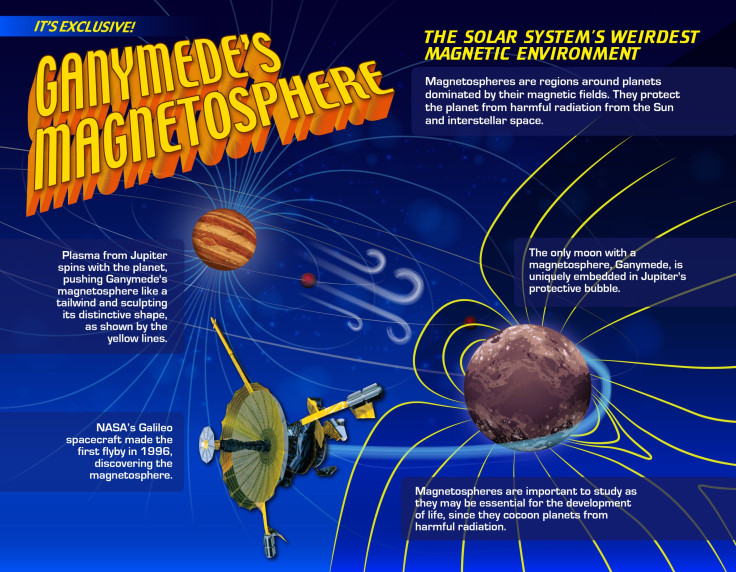Jupiter’s Moon Ganymede Gets Plasma Rain, Shaping Its Unique Magnetosphere: Galileo Data
Since July 2016, NASA’s Juno spacecraft has often made headlines for its study of Jupiter — the largest planet in our solar system — and to a lesser degree, its moons. But a new research paper published Monday used data collected 20 years ago by the space agency’s Galileo spacecraft to draw new conclusions about the gas giant’s largest moon, Ganymede.
Larger than Mercury and Pluto, and twice as massive as the moon we are familiar with here on Earth, Ganymede is the largest natural planetary satellite in the solar system. It is thought to have a large subsurface ocean, sandwiched between two layers of ice and possibly containing more saltwater than all the water in Earth’s oceans.
What makes Ganymede truly unique is its magnetosphere. It is the only known moon to have its own magnetic field, which was discovered by Galileo soon after its arrival at the Jovian system in 1996. Over the following four years, Galileo made six flybys of Ganymede, measuring properties of the plasma in the moon’s surroundings. Some of that data was used for the new paper.
“We are now coming back over 20 years later to take a new look at some of the data that was never published and finish the story. We found there’s a whole piece no one knew about,” Glyn Collinson from NASA’s Goddard Space Flight Center in Greenbelt, Maryland, and lead author of the paper, said in a statement Monday.

Plasma, or electrically charged gas, was seen raining down on Ganymede, causing particles to bounce off the icy surface of the moon. The interplay between the magnetic fields of the moon and its host planet also caused strong flows of plasms between them. Usually, it is the solar wind that shapes the magnetosphere, as is the case with all the planets in the solar system, but Ganymede’s magnetic field is shaped “into a long horn-like shape that stretches ahead of the moon in the direction of its orbit” due to the plasma flow around Jupiter.
The powerful solar wind doesn’t affect Ganymede because it is cocooned within the larger magnetosphere of Jupiter. This shielding property of the magnetosphere protects planets from a lot of harmful space radiation and is therefore an important factor in sustaining life as we know it. Earth’s magnetic field plays this role too, along with causing phenomena like orienting compass needles in a north-south direction and the display of auroras near the polar regions.
Since Ganymede has a magnetosphere, it has auroras as well, and they are unusually bright. Ganymede’s auroras, like on Earth, occur at both its north and south polar regions. The precise location of the aurora zones on the moon, however, was confirmed with data from the Hubble Space Telescope.

Galileo’s Plasma Subsystem instrument (PLS) had also observed an explosive event called magnetic reconnection taking place around Ganymede. It refers to the magnetic lines in a field getting tangled up, snapping and reconnecting, leading to the strong flows of plasms between Jupiter and its largest moon. This event is thought to contribute to making the moon’s auroras particularly bright. There could also be a link to the subsurface ocean to the direction of the auroras.
“There are these particles flying out from the polar regions, and they can tell us something about Ganymede’s atmosphere, which is very thin. It can also tell us about how Ganymede’s auroras form,” Bill Paterson, a co-author of the study at NASA Goddard, who served on the Galileo PLS team during the mission, said in the statement.
The paper, titled “New Results From Galileo's First Flyby of Ganymede: Reconnection‐Driven Flows at the Low‐Latitude Magnetopause Boundary, Crossing the Cusp, and Icy Ionospheric Escape,” appeared online in the journal Geophysical Research Letters.
© Copyright IBTimes 2024. All rights reserved.




















